Cell and Cell Organelles Chapter Notes | Biology for SSS 1 PDF Download
| Table of contents |

|
| Introduction |

|
| Cell and Cell Theory |

|
| What is the Structural Organisation of a Cell? |

|
| Cell Structures and Functions |

|
| Prokaryotic and Eukaryotic Cells |

|
| Cell Organelles |

|
| Cell Division |

|
Introduction
The cell is the essential unit of life, acting as the basic building block for all living things. It was first identified by Robert Hooke in 1665 when he examined a cork slice using a simple microscope. He noticed small, honeycomb-like structures which he named 'cells', a term derived from the Latin word for 'Tiny room'.
- Leeuwenhoek (1674) observed free-living cells in pond water for the first time using an improved microscope.
- Robert Brown discovered the nucleus within the cell in 1831.
- Purkinje introduced the term 'protoplasm' for the cell's fluid content in 1839.
- The cell theory, which states that all plants and animals are made of cells and that the cell is the fundamental unit of life, was proposed by biologists Schleiden (1838) and Schwann (1839).
- Virchow (1855) expanded the cell theory by asserting that all cells originate from pre-existing cells.
- The invention of the electron microscope in 1940 allowed scientists to explore and understand the complex structures of cells and their various organelles.
 Robert Hooke discovered Cell
Robert Hooke discovered Cell
Note: By peeling off a thin layer from an onion, placing it in water, and putting it on a glass slide with a special stain, we can use a microscope to see the onion's cells clearly.
The structures we see under the microscope are similar and together make up the onion bulb. All onion cells look the same, no matter the size of the onion. These small structures are called cells, and they are the building blocks of the onion. All living things are made of cells, and some cells can live on their own.
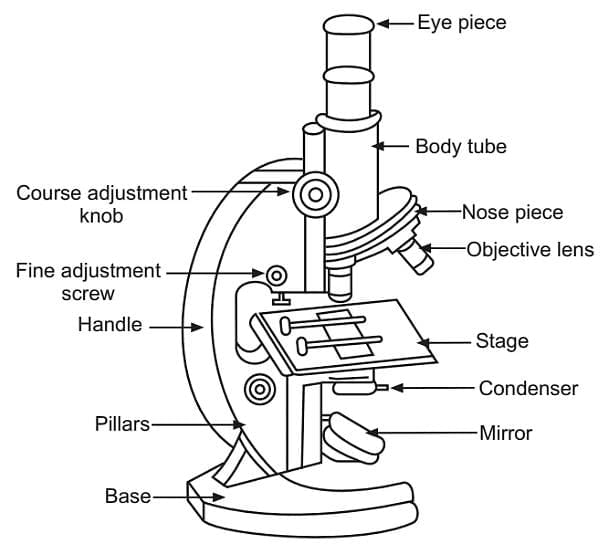
Cell and Cell Theory
A cell is the basic building block and functional unit of all living things.
- Cell Theory: This theory states that all plants and animals are made up of cells, and that the cell is the fundamental unit of life. It was introduced by biologists Schleiden (1838) and Schwann (1839). Virchow (1855) later expanded on this by proposing that all cells come from existing cells. In 1839, Purkinje named the fluid inside cells as 'protoplasm'. The invention of the electron microscope in 1940 allowed scientists to see and study the intricate structure of cells and their different parts.
Types of Organisms
Based on the number of cells, organisms are classified into two categories:
(a) Unicellular Organisms: These are single-celled organisms that carry out all life functions independently. Examples include Amoeba, Paramecium, and various types of bacteria.
(b) Multicellular Organisms: These organisms are made up of many cells that work together, each taking on different roles to form various body parts. Examples include fungi, plants, and animals.
- The shape and size of cells relate to their specific functions. There is a division of tasks among cells. Interestingly, all cells contain the same organelles, no matter their function or the type of organism they belong to.
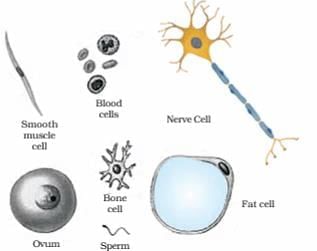 Different Types of Cells
Different Types of Cells
What is the Structural Organisation of a Cell?
Cells, which are the basic units of life, contain specialised parts known as organelles. These organelles enable the cell to perform various functions and engage with its environment.

(a) Plasma Membrane or Cell Membrane
The plasma membrane is the outer layer of the cell that separates its contents from the outside environment. It allows certain materials to enter and exit the cell while blocking others, making it a selectively permeable membrane.
How does the movement of substances take place into the cell?
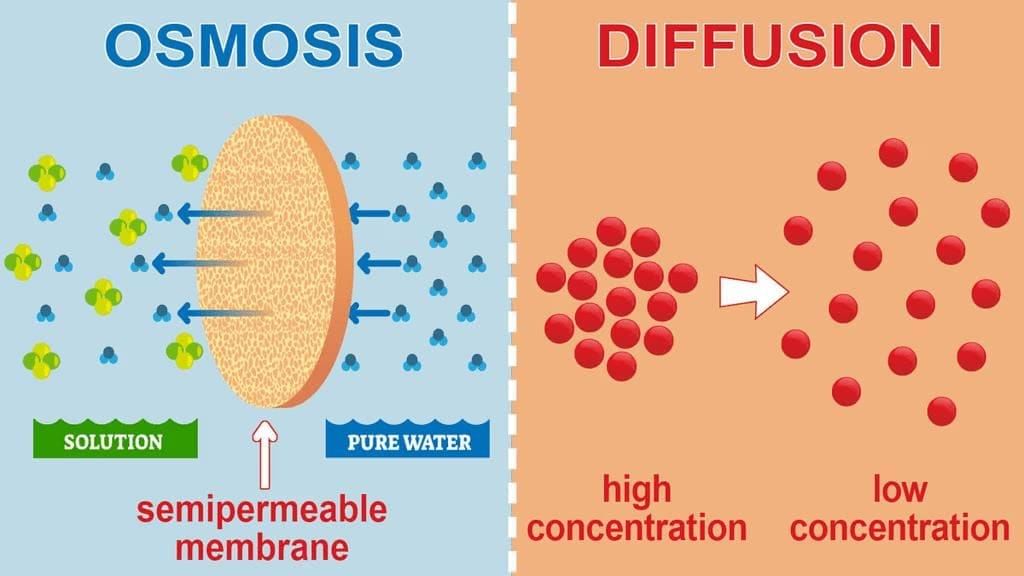
Types of Movement
- Diffusion (For movement of gas): This is the natural movement of a substance from an area of high concentration to an area of low concentration. Gases like carbon dioxide or oxygen can pass through the cell membrane by diffusion. Other molecules require energy for transport in and out of the cell.
- Osmosis (For Movement of Water): This refers to the movement of water molecules through a selectively permeable membrane along the concentration gradient. Plant cells typically absorb water this way. Osmosis is essentially diffusion but specific to water, moving towards a higher concentration of solutes.
Do you know: Osmosis is special case of diffusion
The movement of water across the plasma membrane is also affected by the amount of substance dissolved in water. Thus, osmosis is the net diffusion of water across a selectively permeable membrane toward a higher solute concentration.
What happens if we place an animal or plant cell in a sugar or salt solution? One of three outcomes may occur:
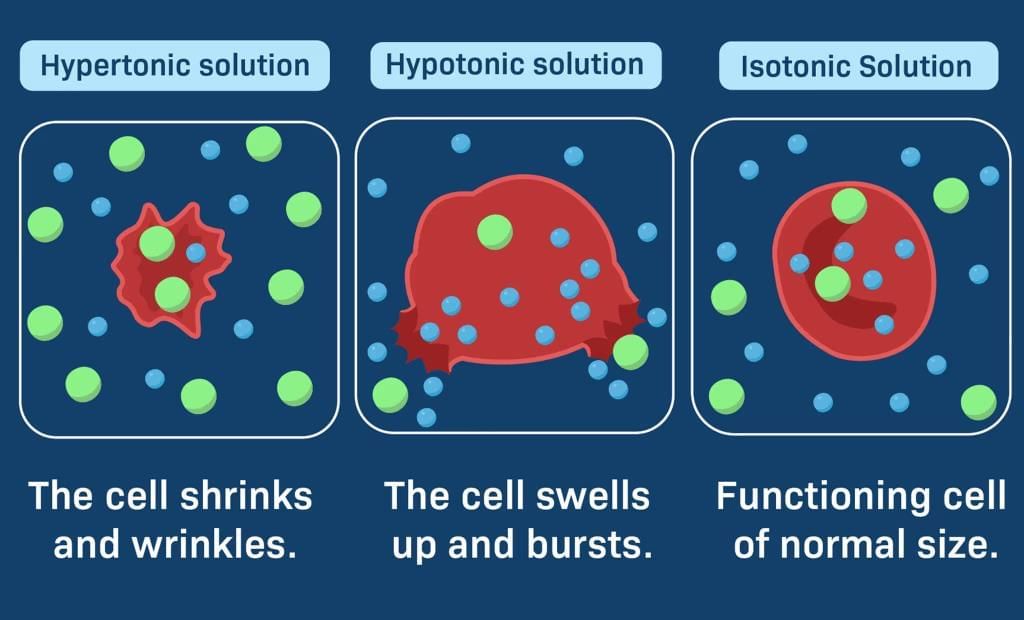
- Hypotonic Solution: If the surrounding solution has a higher concentration of water than the cell, the cell will absorb water through osmosis. This is known as a hypotonic solution, leading to more water entering the cell than leaving it.
- Isotonic Solution: If the surrounding solution has the same concentration of water as the cell, there will be no net movement of water across the cell membrane. This is an isotonic solution, where water moves in and out at equal rates.
- Hypertonic Solution: If the surrounding solution has a lower concentration of water than the cell, the cell will lose water through osmosis. This is a hypertonic solution, causing the cell to shrink as water exits.
In addition to the plasma membrane, plant cells possess a rigid outer layer known as the cell wall. This wall is located outside the plasma membrane and is primarily made of cellulose, which provides structural support to plants.
When a living plant cell loses water through osmosis, it may shrink or contract away from the cell wall. This process is referred to as plasmolysis.
Now let us try out the following activity: (a) Osmosis with an egg.
Cell Structures and Functions
If the surrounding solution has a lower concentration of water than the cell, which means it is a very concentrated solution, the cell will lose water through a process called osmosis. This type of solution is referred to as a hypertonic solution.
- Water moves across the cell membrane, but more water exits the cell than enters, leading to the cell shrinking.
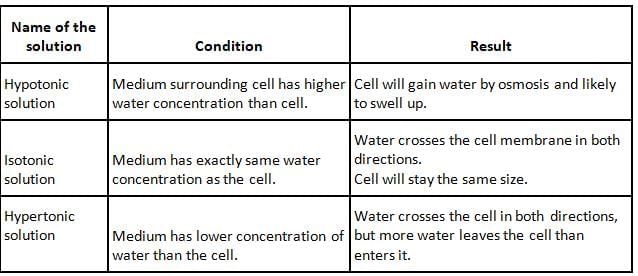
(b) Cell Wall
In addition to the plasma membrane, plant cells have a tough outer layer called the cell wall. This wall is located outside the plasma membrane and is mainly made of cellulose, a complex substance that gives plants their structural strength.
Function of Cell Wall
- Cell walls allow plant, fungal, and bacterial cells to endure very dilute (hypotonic) external solutions without bursting. In such solutions, cells absorb water through osmosis, causing them to swell and exert pressure against the cell wall. The wall then pushes back, creating equal pressure.
- Due to their walls, plant cells can handle much larger changes in their environment compared to animal cells.
- Plasmolysis: This occurs when a living plant cell loses water by osmosis, resulting in the cell contents shrinking away from the cell wall.
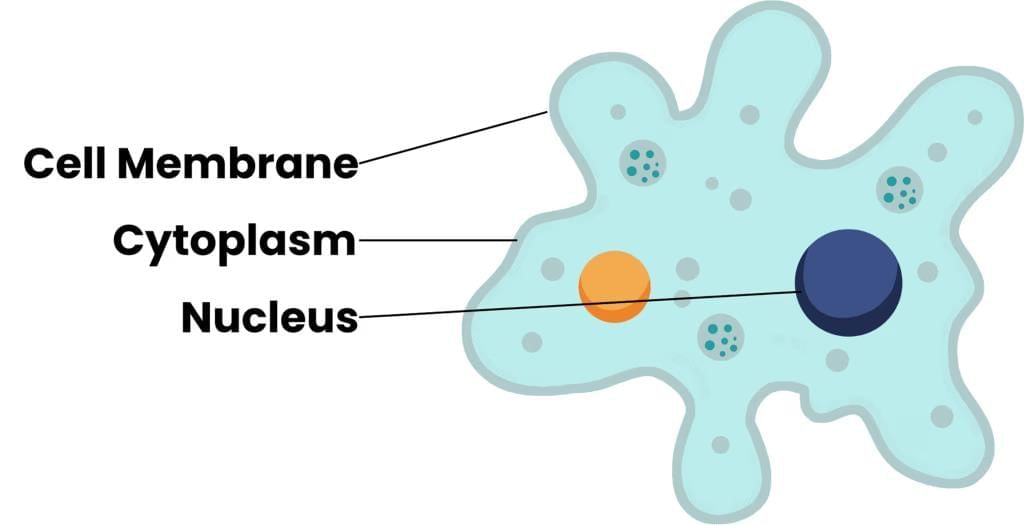 Animal Cell
Animal Cell
(c) Nucleus
The nucleus manages all the activities of the cell. It is surrounded by a double-layered membrane known as the nuclear membrane, which has pores that allow materials to move between the nucleus and the cytoplasm.
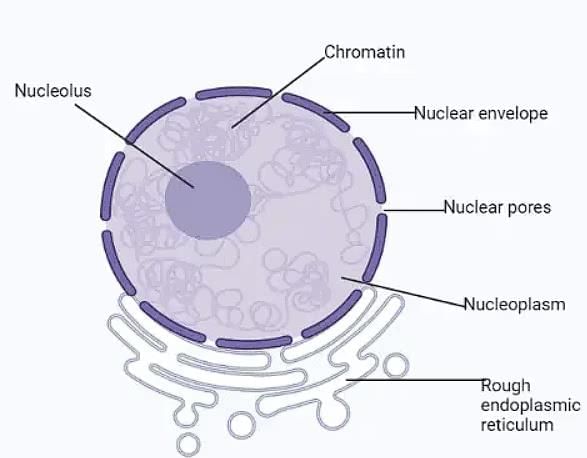 Nucleus of a Eukaryotic cell
Nucleus of a Eukaryotic cell
- Chromosomes and DNA: The nucleus contains chromosomes made of DNA and proteins, which carry genetic information essential for inheritance. DNA in these chromosomes organises all cell structures and functions.
- Chromatin: When the cell is not dividing, DNA exists as chromatin, a tangled mass of thread-like structures. This chromatin forms visible chromosomes during cell division.
- Cellular Reproduction: The nucleus is vital for cellular reproduction, overseeing the cell's development by managing its chemical activities and determining its final form.
Prokaryotic and Eukaryotic Cells
Prokaryotic Cells
- Prokaryotes are organisms with cells that do not have a nuclear membrane.
- Typically, prokaryotic cells are small, ranging from 1 to 10 µm in size.
- They contain a nucleoid, which is an area with nucleic acids but lacks a surrounding membrane.
- Prokaryotic cells do not have membrane-bound organelles.
- They possess a single chromosome made of nucleic acid.
Eukaryotic Cells
- Eukaryotes are organisms with cells that have a nuclear membrane.
- Eukaryotic cells are generally larger, measuring from 5 to 100 µm.
- They have a defined nuclear membrane and contain multiple chromosomes.
- Eukaryotic cells include complex organelles that perform specific functions.
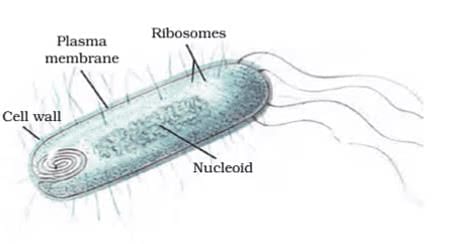 A prokaryotic cell and it's Nucleiod
A prokaryotic cell and it's Nucleiod
Functions of Chromosomes
- Chromosomes carry information for passing traits from parents to offspring through DNA (Deoxyribonucleic Acid) molecules.
- They consist of DNA and protein.
- Functional segments of DNA are known as genes.
- In non-dividing cells, DNA exists as part of chromatin, which appears as a tangled mass of thread-like structures.
- When a cell is preparing to divide, the chromatin condenses into chromosomes, enabling cell division.
Functions of the Nucleus
- The nucleus is key in cellular reproduction, where one cell divides to form two new cells.
- It is surrounded by a double-layered membrane, separating it from the cytoplasm.
- The nucleus influences how a cell develops and what characteristics it will have as it matures, by directing its chemical activities.
Nucleoid
- In some organisms, such as bacteria, the nuclear region is not well defined due to the lack of a nuclear membrane.
- This undefined area, which contains only nucleic acids, is referred to as a nucleoid.
Cytoplasm
- The cytoplasm is the fluid inside the plasma membrane.
- It contains various specialised cell organelles, each with specific roles.
- The cytoplasm facilitates the exchange of materials between organelles.
- It also stores essential chemicals like amino acids, glucose, vitamins, and iron.
- The cytoplasm is where certain metabolic pathways, such as glycolysis, take place.
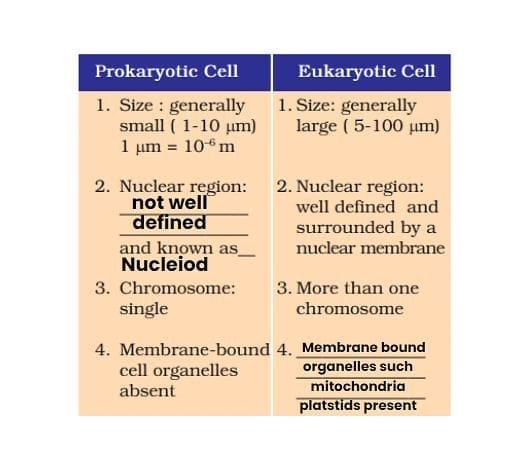
Cell Organelles
Organelles are specialised structures that perform different tasks within cells. The term literally means “little organs.” Just as organs like the heart, liver, stomach, and kidneys have specific functions to keep an organism alive, organelles have specific roles to support the life of a cell.
1. Endoplasmic Reticulum (ER)
The endoplasmic reticulum (ER) is a large network of membrane-bound tubes and sheets that resemble long tubules or round bags called vesicles. The structure of the ER membrane is similar to that of the plasma membrane, made up of lipids and proteins. There are two types of ER: rough endoplasmic reticulum (RER) and smooth endoplasmic reticulum (SER).
Although the ER can look different in various cells, it consistently forms a network system.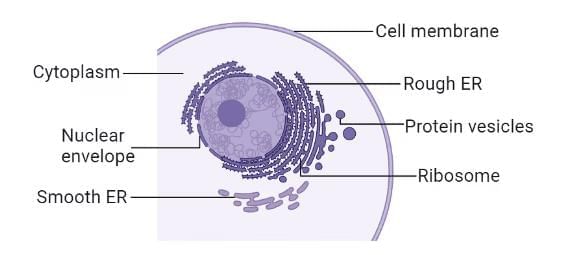 Endoplasmic Reticulum
Endoplasmic Reticulum
Types of Endoplasmic Reticulum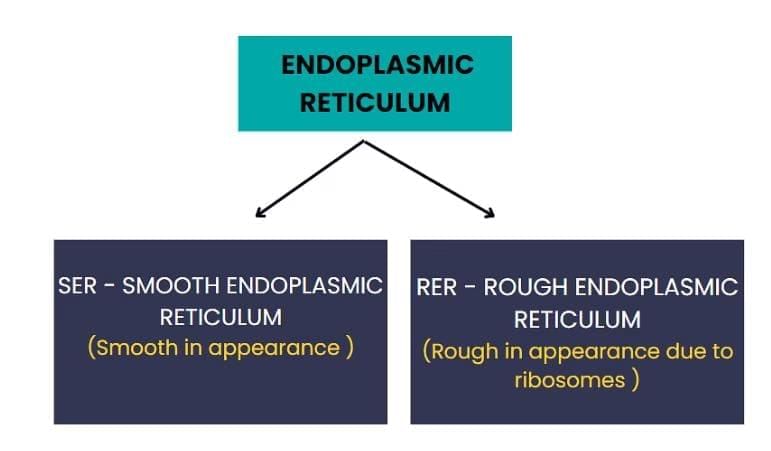
Functions of Rough and Smooth Endoplasmic Reticulum
- The RER contains ribosomes, which are the sites for protein production. These proteins are transported to different parts of the cell as needed.
- The SER aids in creating lipids, which are essential for cell function.
- Some proteins and lipids serve as enzymes and hormones.
- The ER acts as channels, transporting materials (especially proteins) within the cytoplasm or between the cytoplasm and the nucleus.
- The endoplasmic reticulum provides a cellular framework in the cytoplasm, supporting specific cell activities.
- In vertebrate liver cells, the SER is vital for detoxifying various poisons and drugs.
2. Golgi Apparatus
The Golgi apparatus is made up of a system of membrane-bound vesicles that are arranged in stacks known as cisterns. These membranes often connect with the membranes of the ER, forming part of a complex cellular membrane system. 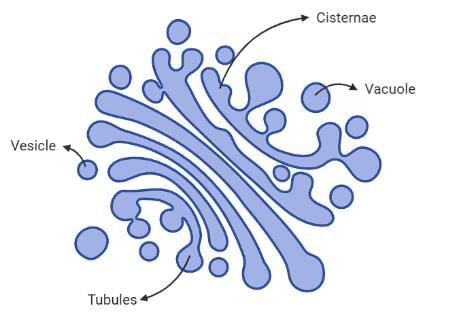 GOLGI APPARATUS
GOLGI APPARATUS
Function of Golgi Body
- The material synthesised near the ER is packaged and dispatched to various targets inside and outside the cell through the Golgi apparatus.
- Its functions include the storage, modification and packaging of products in vesicles. In some cases, complex sugars may be made from simple sugars in the Golgi apparatus.
- The Golgi apparatus is also involved in the formation of lysosomes.
3. Lysosomes
Lysosomes act as the waste disposal system of the cell. They have a membrane-bound structure and contain digestive enzymes made by the rough endoplasmic reticulum (RER).
Functions of Lysosomes
- Lysosomes break down foreign materials entering the cell, like bacteria or food, and also old organelles into smaller pieces.
- They contain powerful digestive enzymes that turn complex substances into simpler ones.
- They break down old organelles.
- If the cell is damaged, lysosomes may burst and the enzymes can digest their own cell. Hence, lysosomes are sometimes called the 'suicide bags' of a cell.
4. Mitochondria
Mitochondria are known as the powerhouse of the cell.
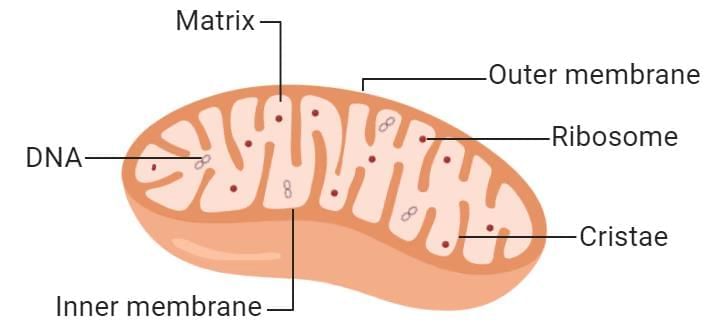
Structure of Mitochondria
- Mitochondria have two membrane coverings.
- The outer membrane is very porous, while the inner membrane has deep folds. These folds create a large surface area for ATP-generating chemical reactions.
Functions of Mitochondria
- Mitochondria release energy needed for various chemical processes required for life in the form of ATP (Adenosine triphosphate) molecules. ATP is recognised as the energy currency of the cell.
- The body uses energy stored in ATP to create new chemical compounds and for mechanical work.
- Mitochondria are unique as they have their own DNA and ribosomes, allowing them to produce some of their own proteins.
5. Plastids
Plastids are found only in plant cells.
There are two types of plastids:
- Chromoplasts (coloured plastids).
- Leucoplasts (colourless plastids), which mainly store materials like starch, oils, and protein granules.
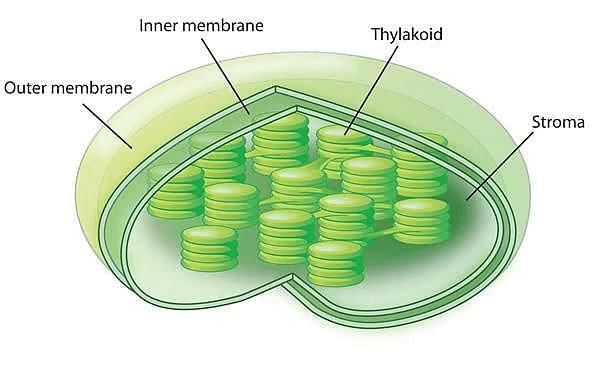 A PLASTID
A PLASTID
Structure of Plastids
- The plastids' internal structure includes multiple layers of membranes surrounded by a substance known as the stroma.
- Plastids also have their own DNA and ribosomes like mitochondria and similar to its mitochondria in it's structure
Function of Plastids
- Chloroplasts are important for photosynthesis in plants.
- Leucoplasts are primarily organelles in which materials such as starch, oils and protein granules are stored.
6. Vacuoles
Vacuoles are storage sacs that hold solid or liquid materials. In animal cells, they are typically small, while in plant cells, they can be quite large. The central vacuole in some plant cells may take up 50-90% of the cell's volume. In plant cells, vacuoles are filled with cell sap, which helps maintain the cell's turgidity and rigidity. Vacuoles store various essential substances for the plant cell, such as:
- Amino acids
- Sugars
- Organic acids
- Proteins
In single-celled organisms like Amoeba, the food vacuole contains the food that the organism has consumed. Additionally, in some unicellular organisms, specialised vacuoles are crucial for removing excess water and waste from the cell.
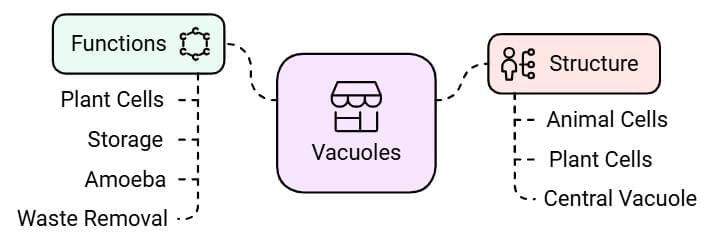
Cell Division
The process of creating new cells is known as cell division. New cells are produced in living organisms to:
- grow
- replace old, dead, and damaged cells
- form gametes needed for reproduction
There are two main types of cell division: mitosis and meiosis.
Mitosis or Mitotic Cell Division
Mitosis is the process through which most cells divide for growth. In this process, each original cell, known as the mother cell, splits to create two genetically identical daughter cells (Fig. 5.7). The daughter cells have the same number of chromosomes as the mother cell. This process is essential for the growth and repair of tissues in organisms.
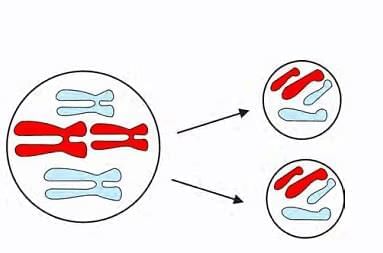 MITOSIS
MITOSIS
Meiosis or Meiotic Cell Division
In animals and plants, certain cells in reproductive organs or tissues divide to create gametes, which will develop into offspring after fertilisation. This division occurs through a different method called meiosis, which involves two successive divisions. When a cell undergoes meiosis, it produces four new cells instead of just two (Fig. 5.8). These new cells contain only half the number of chromosomes compared to the mother cells.
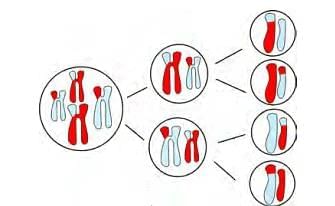 MEIOSIS
MEIOSIS
Difference between Animal Cell and Plant Cell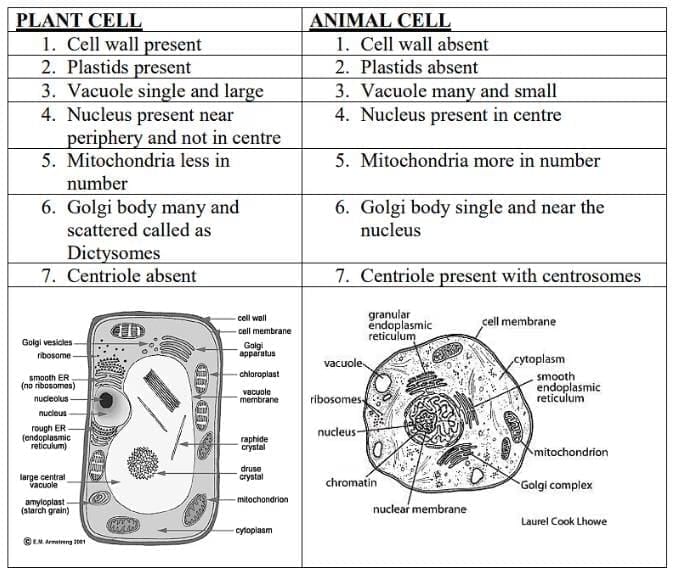
|
25 videos|104 docs|22 tests
|
FAQs on Cell and Cell Organelles Chapter Notes - Biology for SSS 1
| 1. What is cell theory, and who were its main contributors? |  |
| 2. What are the main differences between prokaryotic and eukaryotic cells? |  |
| 3. What are the primary functions of cell organelles? |  |
| 4. How does cell division occur in both prokaryotic and eukaryotic cells? |  |
| 5. What is the significance of understanding cell structures and their functions? |  |














